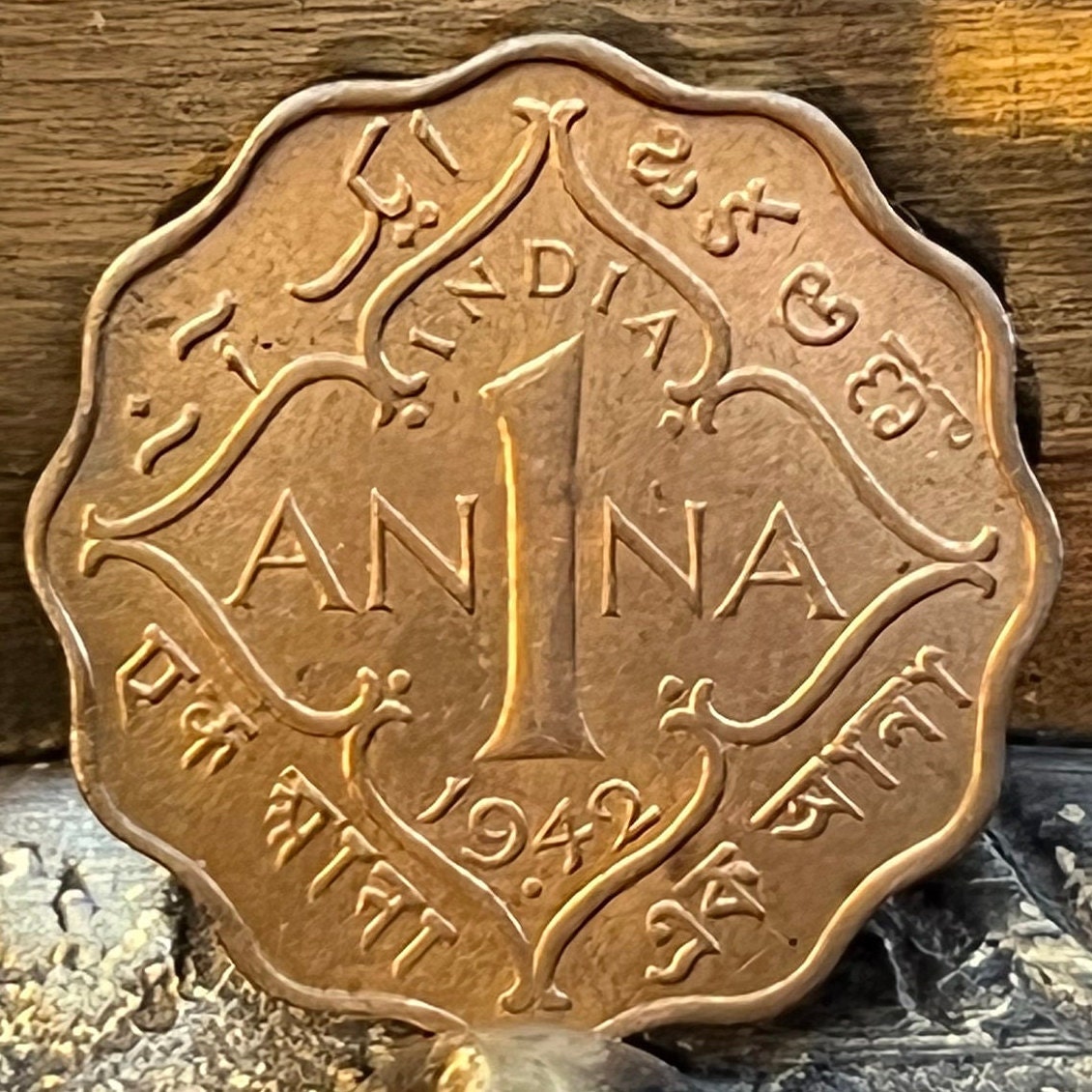elemintalshop
One Anna & George VI King Emperor 1 Anna British India Authentic Coin Money for Jewelry (British Raj) (Emperor) (Scalloped) (Quadrilingual)
One Anna & George VI King Emperor 1 Anna British India Authentic Coin Money for Jewelry (British Raj) (Emperor) (Scalloped) (Quadrilingual)
Couldn't load pickup availability
One Anna & George VI King Emperor 1 Anna British India Authentic Coin Money for Jewelry and Craft Making (British Raj) (Emperor of India) (Quadrilingual) (Scalloped Coin)
Obverse: Crowned head of King George VI facing left with his name and role in English around the rim
Lettering: GEORGE VI KING EMPEROR
Reverse: Denomination, date below within floral pattern and the value in four languages: Urdu, Telugu, Bengali & Devanagari outside.
Lettering:
ایک آن ఒకఅణా
INDIA
AN 1 NA
एक आना এক আনা
Translation: One Anna
Features
Issuer India - British (British India)
King George VI (1936-1952)
Type Standard circulation coin
Years 1942-1945
Value 1 Anna = 1/16 Rupee (1/16)
Currency Rupee (1862-1947)
Composition Nickel brass
Weight 3.89 g
Diameter 20.5 mm
Thickness 1.5 mm
Shape Scalloped (with 12 notches)
Technique Milled
Orientation Medal alignment ↑↑
Demonetized Yes
Number N# 1617
References KM# 537a
WIkipedia:
George VI (Albert Frederick Arthur George; 14 December 1895 – 6 February 1952) was King of the United Kingdom and the Dominions of the British Commonwealth from 11 December 1936 until his death in 1952. He was concurrently the last Emperor of India until August 1947, when the British Raj was dissolved.
Known as "Bertie" among his family and close friends, George VI was born in the reign of his great-grandmother Queen Victoria and was named after his great-grandfather Albert, Prince Consort. As the second son of King George V, he was not expected to inherit the throne and spent his early life in the shadow of his elder brother, Edward. He attended naval college as a teenager and served in the Royal Navy and Royal Air Force during the First World War. In 1920, he was made Duke of York. He married Lady Elizabeth Bowes-Lyon in 1923, and they had two daughters, Elizabeth and Margaret. In the mid-1920s, he had speech therapy for a stammer, which he learned to manage to some degree. George's elder brother ascended the throne as Edward VIII after their father died in 1936. Later that year, Edward abdicated to marry the twice-divorced American socialite Wallis Simpson, and George became the third monarch of the House of Windsor.
In September 1939, the British Empire and Commonwealth—but not Ireland—declared war on Nazi Germany. War with the Kingdom of Italy and the Empire of Japan followed in 1940 and 1941, respectively. George was seen as sharing the hardships of the common people and his popularity soared. Buckingham Palace was bombed during the Blitz while the King and Queen were there, and his younger brother, the Duke of Kent, was killed on active service. George became known as a symbol of British determination to win the war. Britain and its allies were victorious in 1945, but the British Empire declined. Ireland had largely broken away, followed by independence of India and Pakistan in 1947. George relinquished the title of Emperor of India in June 1948 and instead adopted the new title of Head of the Commonwealth. He was beset by smoking-related health problems in the later years of his reign and died of coronary thrombosis in 1952. He was succeeded by his daughter, Elizabeth II.
******
Wikipedia:
The British Raj (from Hindi rāj: kingdom, realm, state, or empire) was the rule of the British Crown on the Indian subcontinent from 1858 to 1947. The rule is also called Crown rule in India, or direct rule in India. The region under British control was commonly called India in contemporaneous usage and included areas directly administered by the United Kingdom, which were collectively called British India, and areas ruled by indigenous rulers, but under British paramountcy, called the princely states. The region was sometimes called the Indian Empire, though not officially.
As "India", it was a founding member of the League of Nations, a participating nation in the Summer Olympics in 1900, 1920, 1928, 1932, and 1936, and a founding member of the United Nations in San Francisco in 1945.
This system of governance was instituted on 28 June 1858, when, after the Indian Rebellion of 1857, the rule of the British East India Company was transferred to the Crown in the person of Queen Victoria (who, in 1876, was proclaimed Empress of India). It lasted until 1947, when the British Raj was partitioned into two sovereign dominion states: the Union of India (later the Republic of India) and the Dominion of Pakistan (later the Islamic Republic of Pakistan and the People's Republic of Bangladesh). At the inception of the Raj in 1858, Lower Burma was already a part of British India; Upper Burma was added in 1886, and the resulting union, Burma was administered as an autonomous province until 1937, when it became a separate British colony, gaining its own independence in 1948. It was renamed Myanmar in 1989.
Share










Great collection of coins - love them, fast and reliable shipping, too :)
Great detail and quality item!
Great item for my jewelry projects!
Love this unique coin, very cool!!









